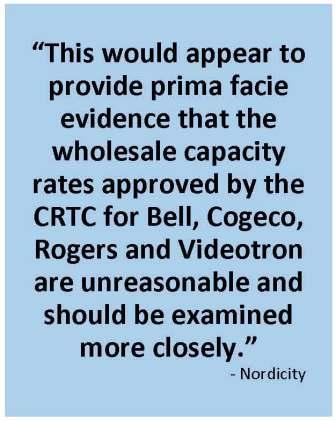
GATINEAU – There was little love for the CRTC when, on the day before St. Valentine’s Day, Videotron filed its appeal of the wholesale Internet billing decision (more popularly known as the usage-based-billing issue). However, the Quebec cableco wasn’t the only provider to let its feelings be known regarding the matter, other network owners as well as the independent ISPs have taken the Commission to task over the appropriate rates for wholesale network access and use.
The issue that never seems to go away is not focused on the capacity-based billing framework, which most agree is a good idea, but rather the rates to be charged to independent ISPs who rely on incumbent networks to provide high-speed Internet service to customers. For the network owners, the rates are too low (and very disparate from company to company) and won’t allow them to recover costs. The indie ISPs argue the rates are too high and that they won’t be able to compete with the large telco and cableco Internet providers.
The incumbents present varying positions as to why the wholesale access decision was wrong, but they all boil down to rates that aren’t sufficiently high and don’t reflect the true cost of providing wholesale network services.
For Quebecor Media’s Videotron subsidiary, the CRTC’s failure to adopt declining rates means it will essentially be subsidizing wholesale access for the small ISPs. The company argues that under the current fixed rate regime, the indie ISPs will be paying substantially lower than the true cost of providing wholesale network access at the outset. It notes in the first year alone, the small ISPs will pay 58% below the true capacity rate ($1890/Mbps versus $4480/Mbps).
“
Rogers Communications Inc. argues that the Regulator erred when it set that the trigger for cost recovery at 75% of peak capacity rather than the 60% the company uses in its calculations. This amounts to giving independent ISPs “a free ride” on Rogers’ network.
“The Commission has used the higher conversion rate which is based on a capacity trigger of 60%, but denied Rogers the ability to recover the costs of using that 60% trigger. The Commission cannot have it both ways – either the conversion factor must be recalculated using a 75% capacity trigger – or Rogers must be permitted to recover the costs associated with the 60% trigger that produces these beneficial results,” the company says in its review and vary application.

Bell Canada also focused on specific aspects of the decision, arguing rates adjustments found in the decision will impede its ability to earn a fair return on wholesale residential fibre-to-the-node (FTTN) network investment. It points to rates associated with network conditioning activities conducted in Ontario and Quebec as one point of contention. Network conditioning is a necessary step required to make high-speed Internet available at both the retail and wholesale level. Specifically, Bell takes issue with the commission’s decision to not allow costs related to networking conditioning done prior to July 2011 in its final rates.
On the other side of the rate coin, the Canadian Network Operators Consortium (CNOC) says that the Commission’s goals of providing consumer choice, pricing discipline and ensuring a competitive market for retail Internet services are actually undermined by its wholesale Internet billing decision. The association commissioned two studies to demonstrate that the rates approved for the cable companies and telcos are just too high and won’t allow for sustained competition in retail internet services.
According to Nordicity’s analysis, Bell is charging rates that are four times higher than what would be incurred by an efficient, least cost network to provide 100 Mbps wholesale capacity. The consulting firm estimates that Bell’s rates should be in the range of $493 per 100Mbps per month (including 26% markup), not the $2,000 approved by the CRTC. Even if technology costs were a factor and required Bell to charge double the Nordicity estimated rate, this is still well below the approved rates.
“This would appear to provide prima facie evidence that the wholesale capacity rates approved by the CRTC for Bell, Cogeco, Rogers and Videotron are unreasonable and should be examined more closely,” Nordicity concludes in its study.
The CRTC has yet to make a decision on whether it will deal with each R&V individually or consolidate them under a new proceeding. The Commission normally waits until the comment and reply comment periods are complete before making any decision.


